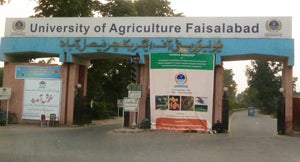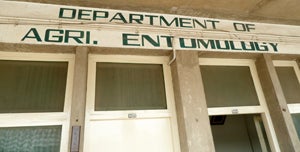
Asian citrus psyllid (ACP) was found in California in late 2008 in San Diego and Imperial Counties. This invasive pest sucks sap from citrus and is a major concern for California because when feeds ACP inject into trees bacteria that cause a lethal disease of citrus known as huanglongbing (HLB). This plant disease is incurable, is restricted to citrus, and poses zero (i.e., no) risk to humans. HLB is also known as yellow shoot disease or citrus greening.
This ACP-HLB combination has been particularly devastating following its arrival in major citrus producing areas. In Florida for example, 60,000 acres of citrus, about 10% of commercial production, was taken out by HLB within 4-5 years of the first detection of the disease. At the time this blog was written (November 2011), HLB had not been detected in California. However, many suspect that the disease is present in California, and could be residing undetected in backyard citrus, possibly in plants that were smuggled into the state from areas where HLB is present (e.g., Asia, Mexico, or Florida).
Since 2008, large ACP populations have developed in Los Angeles (LA), Riverside, and San Bernardino, Counties. The vast majority of infestations found by the California Department of Food and Agriculture’s (CDFA) monitoring program have been detected in urban areas. Citrus is a very popular backyard fruit tree and homeowners grow a large variety of different citrus including oranges, mandarins, lemons, limes, kumquats, and grapefruit. It has been estimated that there is more citrus growing in people’s gardens than there is in all of California’s commercial citrus production areas combined. Surveys by UC Riverside scientists working on ACP in LA have found that ACP is encountered most often on lemons and limes, and populations can reach very high levels on Mexican limes, which appear to be a highly favored host.
Containing ACP in urban areas is a major challenge that the CDFA and Citrus Research Board (CRB) have jointly undertaken. The management plan involves treatments of residential trees that have ACP and neighboring trees within a prescribed distance of the infested tree that triggered treatments. Pesticide applications may include foliar sprays to kill ACP eggs, nymphs, and adults, and soil drenches with approved systemic insecticides that move inside the plant killing ACP when they suck sap. Finding and treating ACP infested citrus is a difficult and expensive task, and some homeowners don’t like the idea of pesticides being applied to citrus in their gardens.
UC Riverside with support from CDFA, CRB, and the Citrus Health Response Program (CHRP) has initiated a classical biological control program for ACP. This approach to ACP control involves finding natural enemies of the pest in its native range. Most scientists who work on psyllids, the group to which ACP belongs, agree that this insect is probably native to parts of central and southern Asia and has been moved unintentionally on citrus into areas where it is not native. Once in these new areas, with lots of citrus to feed on, favorable year round climates, and a lack of specialist natural enemies, ACP populations increase and spread rapidly.
Part of the native range of ACP is the Indian subcontinent, and the very first study on ACP was published by two scientists Mohammad Hussain and Dina Nath in 1927 . They conducted their research on this citrus pest in the Punjab region of modern day Pakistan and India where is it was associated with declines in lemons and oranges. Hussain and Nath (1927) also reported that there were nine species of parasitoid attacking the nymphs of ACP and that parasitism of this pest could sometimes exceed 90-95% at certain times of the year. One species of parasitoid, Tamarixia radiata, an eulophid that preferentially attacks the fourth and fifth instars of ACP was reared described from specimens that emerged from ACP infesting lemon leaves in Lyallpur in 1922!! This parasitoid has been used in Florida, Texas, Mexico, the Caribbean, Central and South America for biological control of ACP.
The Punjab has a very good climatic match (about 70% similar) with the major citrus producing areas in the Central Valley of California. Biological control theory suggests that climates that are similar in the pest’s region of origin and the intended receiving range for natural enemies is important because it increases the likelihood that biological control agents will be well adapted to the climatic conditions in the area into which they could be introduced. There are basically three seasons in the Punjab; cool and foggy (October – February), hot (March-June), baking hot and humid (monsoon season July – September).

The Central Valley is characterized by very hot dry summers and cold foggy winters (Tule fog). It is anticipated that parasitoids of ACP sourced from the Punjab of Pakistan will be well adapted to California’s citrus growing areas.

Foreign exploration for natural enemies of ACP in the Punjab of Pakistan was initiated with a trip over the period 28 August 2010 to 5 September 2011 to assess the potential for collaboration with scientists in the Department of Agri-Entomology at the University of Agriculture Faisalabad (UAF) (Faisalabad was formerly known as Lyallpur). It was quickly determined that UAF would be an excellent base for this project because it had research plots of citrus infested with ACP that were not treated with insecticides, UAF is closely positioned to Sargodha and Toba Tek Singh important commercial citrus production areas in the Punjab, and the Vice Chancellor of UAF, Dr. Iqrar Khan, a MS and Ph.D. graduate from UC Riverside (supervised by Dr. Mikeal Roose) and world leader in HLB research was extremely enthusiastic about developing a joint project between UAF and UC Riverside.


A four week trip to Pakistan over the period 11 March 2011 to 10 April 2011, resulted in the setting up of two research plots in Square 9 and PARS, both of which are UAF citrus research areas. In these two plots ACP and natural enemy population dynamics and flush growth patterns are being studied weekly on two different types of citrus, kinnow and sweet orange. Kinnow, a type of mandarin bred at UC Riverside by H.B. Frost in 1935 and introduced to UAF in 1940 and the first tree was planted in Square 9 one of our current study sites! Kinnow accounts for about 85% of citrus produced in the Punjab and it is an export crop for Pakistan. A Masters Student in Agri-Entomology, Mr. Shouket Zaman Khan was trained to do this work, and he is supervised by Dr. Mohammed Jalal Arif. At the end of this period, 80 Tamarixia radiata (24 males and 56 females) and 70 Diaphorencyrtus aligharhensis (25 males and 45 females) were returned to Quarantine at UC Riverside and used to establish colonies. All living material for this project is moved under USDA-APHIS permit and is cleared at LAX by Homeland Security Personnel before being moved to the Quarantine Facility at UCR.

The third trip to Pakistan to look for ACP natural enemies was conducted over the period 6 June 2011 to 13 June 2011. This trip was very successful and 406 T. radiata (151 males and 255 females) and 25 D. aligarhensis (21 males and 4 females) were returned to UCR’s Quarantine facility.
The fourth collecting trip to Pakistan was completed over 28 October to 4 November 2011. From this collecting trip about 800 T. radiata and approximately 30 D. aligarhensis were brought back to UC Riverside. From all of these collections, just two parasitoids of ACP have been collected, T. radiata and D. aligarhensis. Consequently, we are questioning the validity of Husain and Nath’s (1927) claim that ACP nymphs were attacked by nine different species of parasitoid. Based on our experiences with collecting and rearing large numbers of specimens from Pakistan and from three different time periods it seems unlikely that the parasitoid fauna associated with this pest is diverse.
Shipments of natural enemies carried from Pakistan to UCR are processed in a receiving room in Quarantine. During this initial inspection phase, shipments are checked for accidental contaminants which are eliminated and destroyed immediately. Colonies of these natural enemies are set up in Quarantine at UC Riverside and are maintained as isocage lines to preserve genetic diversity. Maintaining colonies of ACP and its natural enemies in Quarantine is very difficult, time consuming, and requires meticulous attention to detail. Colonies of ACP and natural enemies are double caged, kept in secure rooms that are within secure rooms, and workers must wear coveralls which are removed in a designated changing room once work in the colonies is finished for the day.
T. radiata and D. aligarhensis are undergoing safety testing to ensure that they will pose no undue risk to the environment in California. Release of T. radiata for biological control of ACP in California is anticipated for Spring 2012 once the Environment Assessment Report has been reviewed and approved by USDA-APHIS.